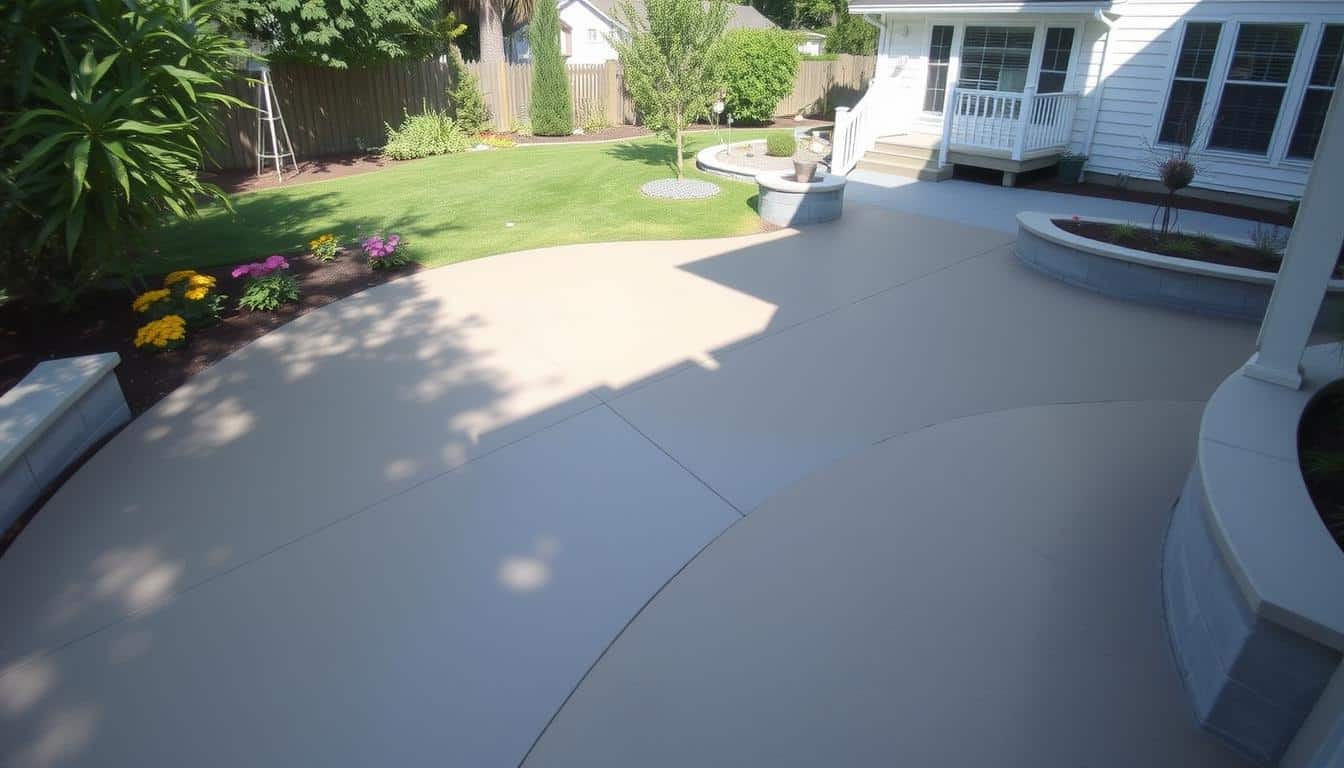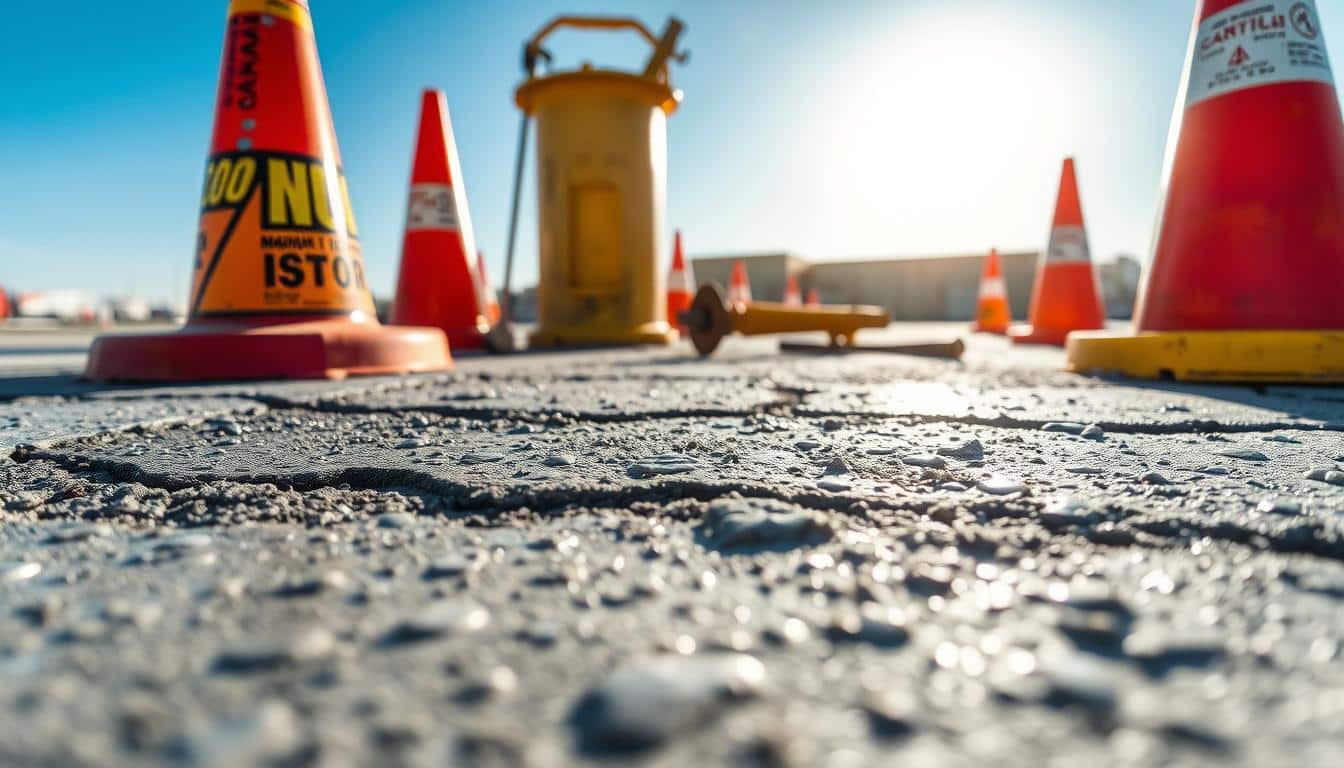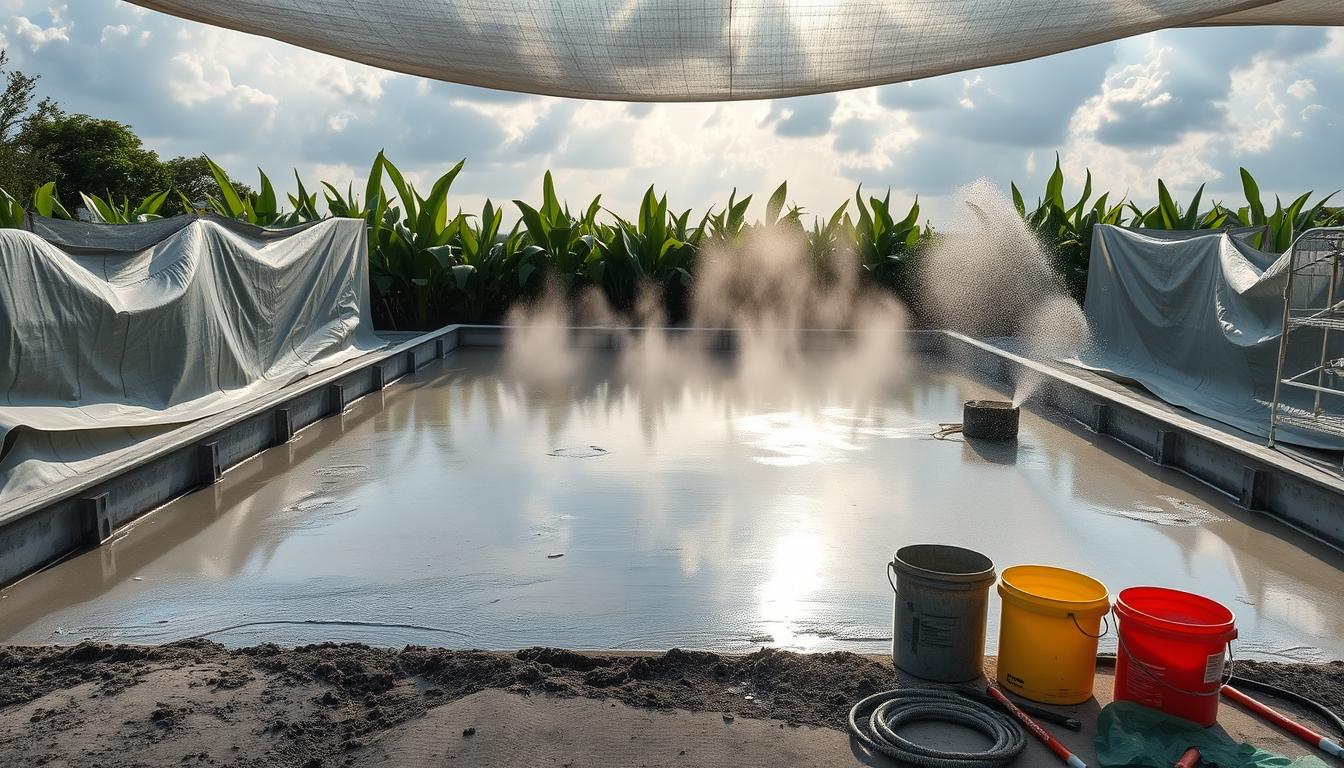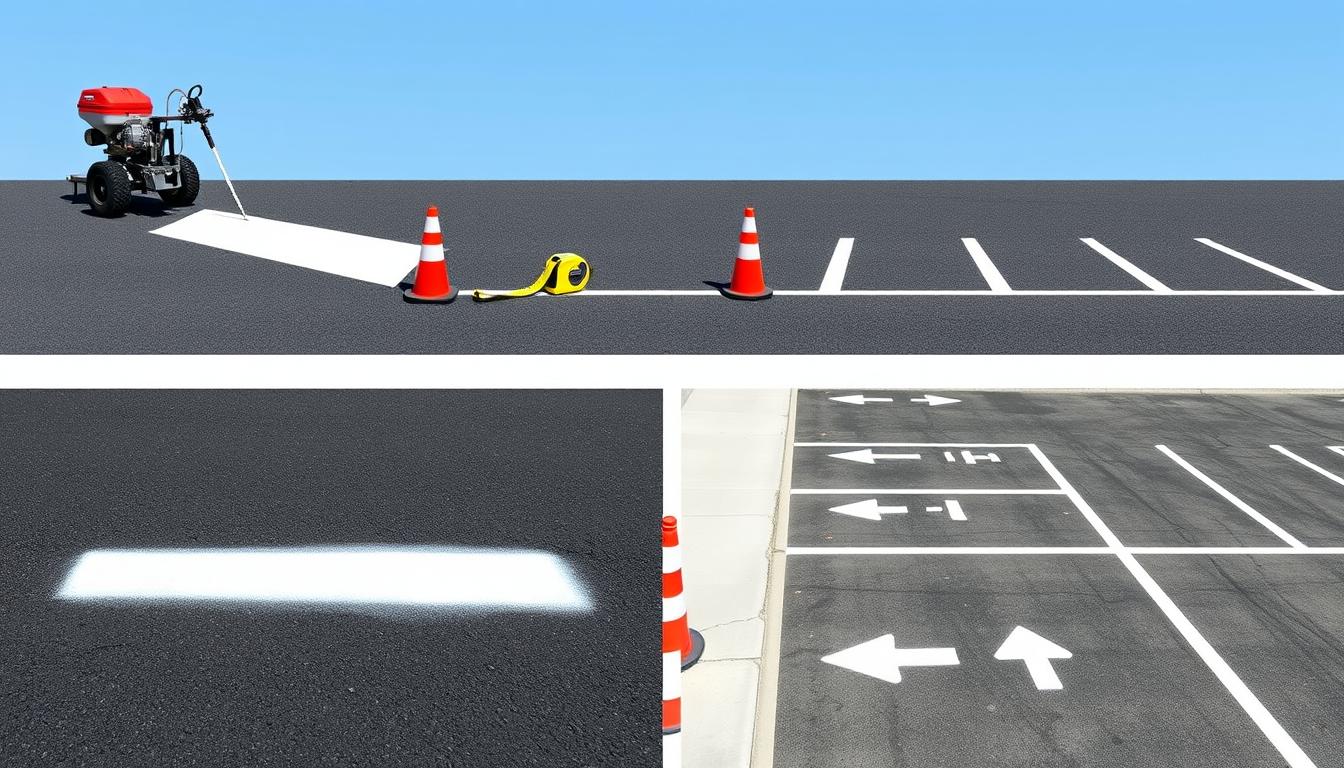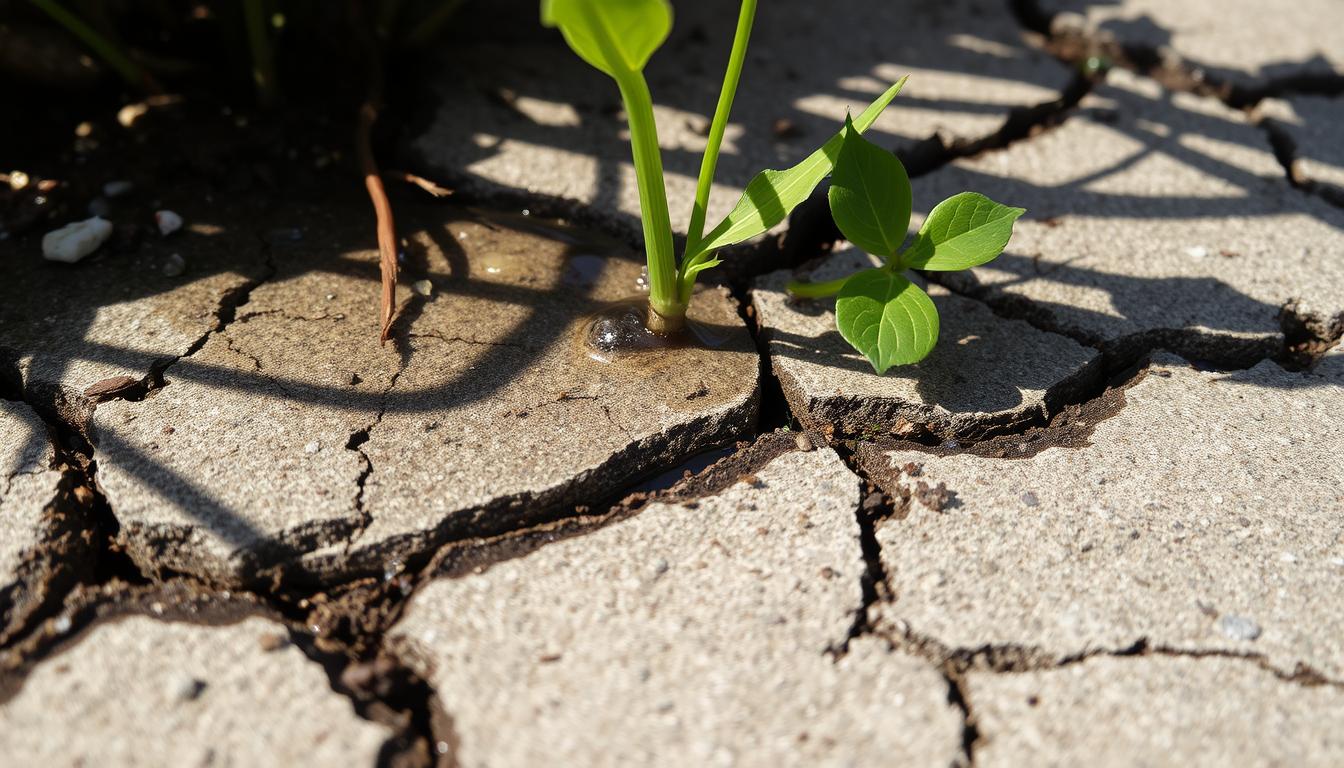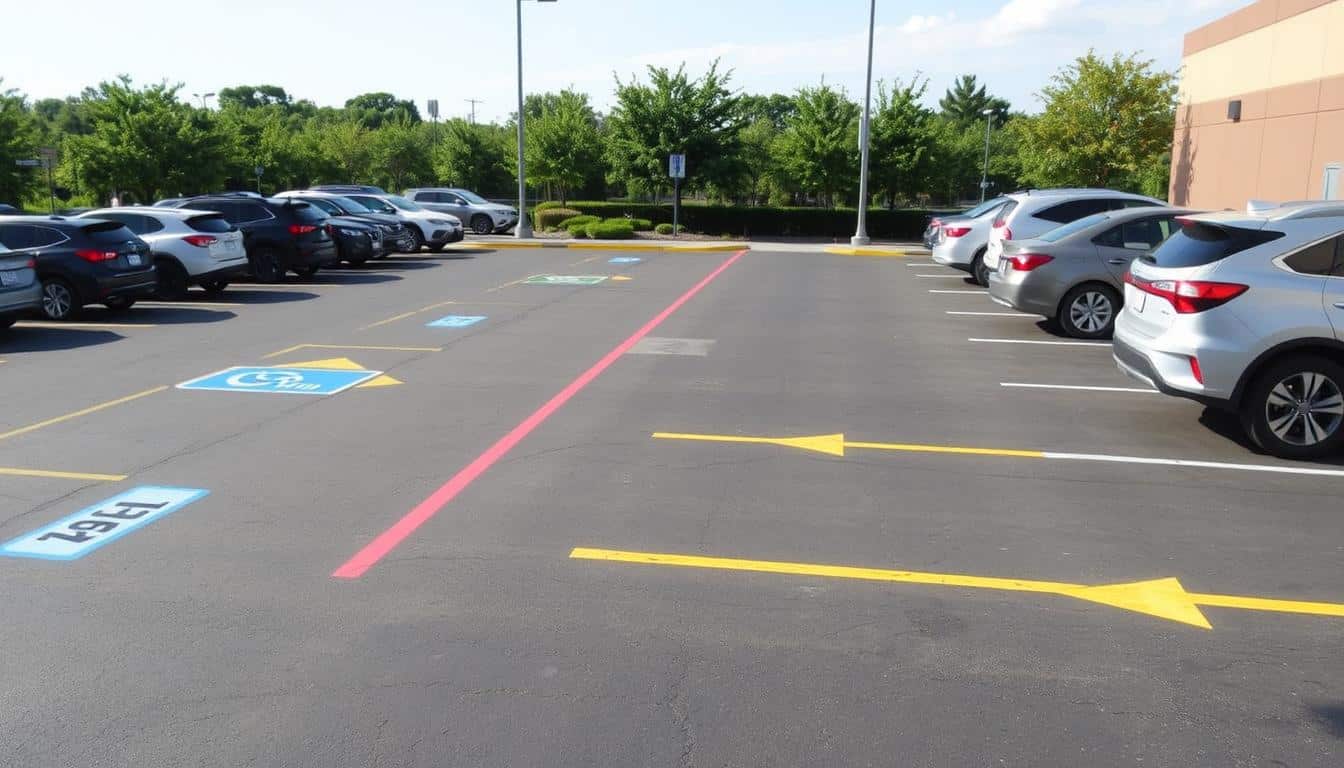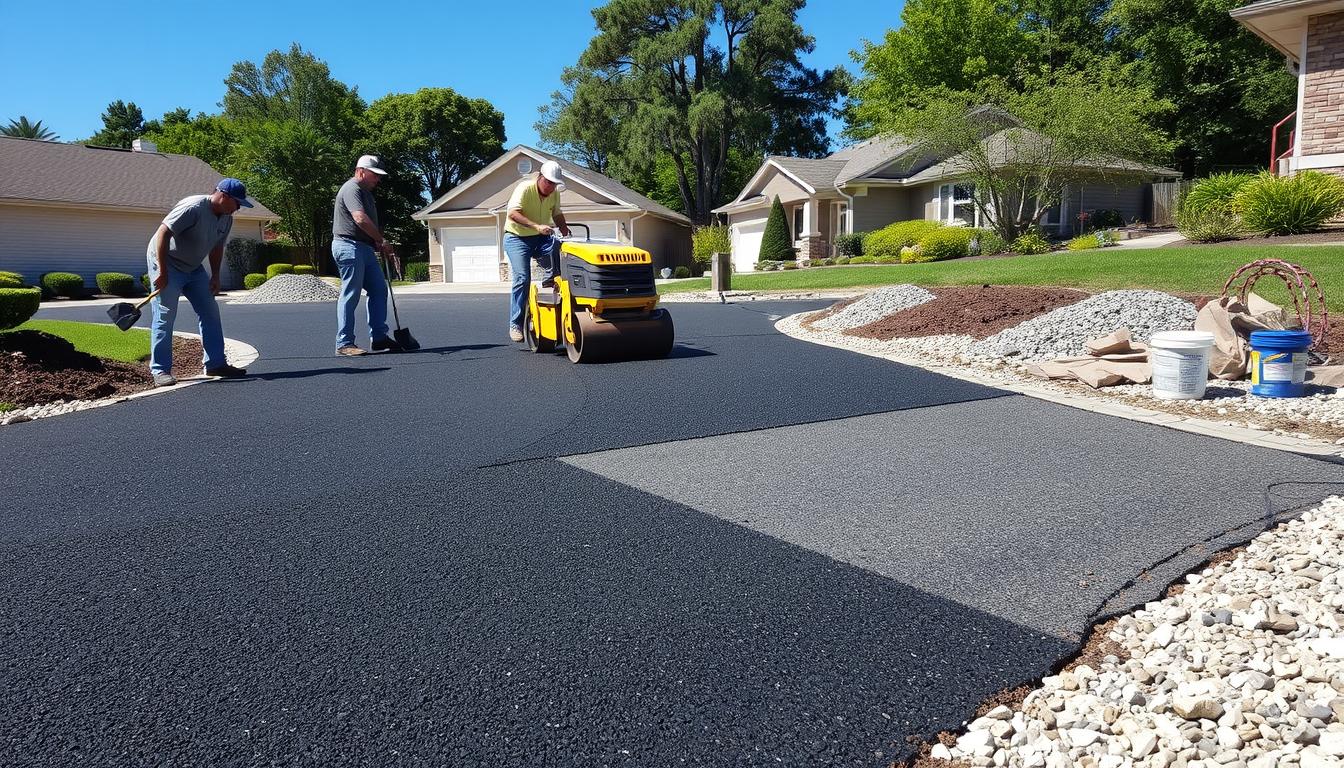Ever wondered how long does it take for repaired concrete to cure? Or why some contractors wait weeks before using it? It’s because they know the curing time. Concrete usually takes about 28 days to fully cure.
This time can change based on temperature, humidity, and the concrete type.
Ignoring the curing process can ruin your repair’s look and make it weak. It can become brittle and crack.
In the next parts, we’ll look closer at the concrete repair timeline. We’ll see why each step is key for the best results. Knowing about concrete cure times helps you make better choices for lasting repairs.
Key Takeaways
- The curing process typically lasts 3 to 7 days for initial curing but can extend up to 28 days or longer for full strength.
- Safe foot traffic on newly poured concrete can usually occur within 24-48 hours after initial setting.
- Environmental factors like temperature and humidity significantly impact curing times and concrete strength.
- Proper curing can enhance compressive strength by as much as 110% over a prolonged period.
- Understanding the nuances of concrete cure time is essential for longevity and durability in repairs.
Understanding Concrete Curing
Concrete curing is the process that keeps moisture in to help the concrete set right. This hydration is key for the concrete’s strength and durability. Managing the curing stages well is important for the structure’s safety and performance.
What is Concrete Curing?
The curing process for concrete keeps it moist and at the right temperature. It starts when the concrete is first poured and goes on for days. The surface hardens in 24 to 48 hours, but it takes weeks for the concrete to fully strengthen.
By seven days, the concrete is about 70% strong. So, early care is very important.
Importance of Curing in Construction
Curing is key for concrete structures to last long. Without it, cracks and surface issues can happen, weakening the structure. Paying attention to curing stages boosts the material’s performance.
Using good curing methods also protects against damage from early traffic and harsh weather during hydration.
Factors Affecting Curing Time
Several things can change how long concrete takes to cure. Temperature is a big factor; the best range is 50°F to 70°F. Too hot or too cold slows it down.
Humidity is also important; high humidity keeps moisture in, helping hydration. The thickness of the concrete and the mix design also affect curing time. Thicker slabs need more time to cure fully.
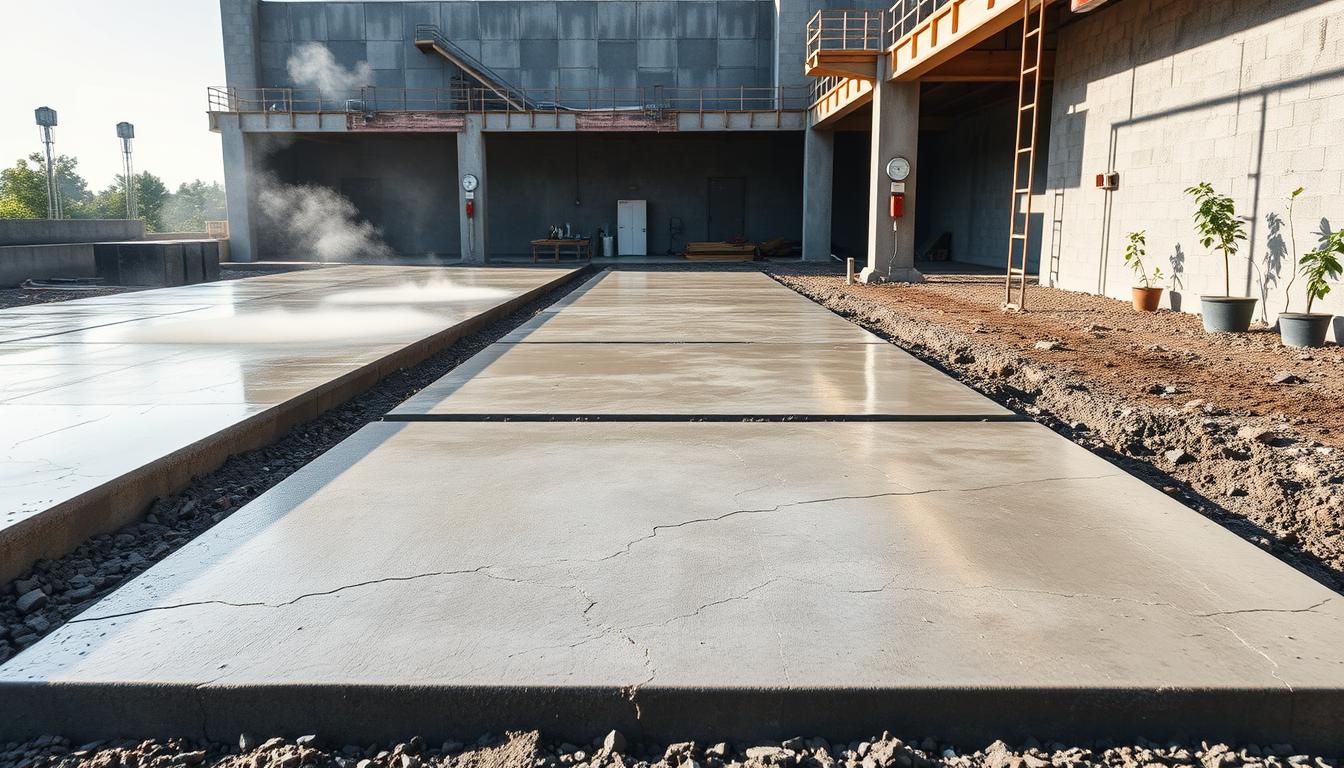
Typical Cure Times for Concrete Repairs
Knowing how long concrete repairs take is key to keeping them strong and lasting. The type of concrete and the environment around it affect how long it takes to cure. This section will cover typical curing times and what can change them.
Standard Cure Times for Different Types
Concrete is usually ready to walk on in 24 to 48 hours. Most cars can drive on it in 5 to 6 days. But big trucks might need longer. It takes 27 days for concrete to be at its strongest.
Thicker concrete takes longer to cure. Special concrete mixes can take 14 to 28 days. It’s important to start the curing process right away to avoid cracks.
Comparing Curing Times: Weather Impact
The weather can change how long concrete takes to cure. Too much moisture or humidity slows it down. But warmer weather can speed it up.
Wind can be tricky. It might help cure the concrete faster, but strong gusts can weaken it. So, it’s important to watch the weather while curing.
Curing Times for Decorative Concrete
Decorative concrete repairs need time to cure, just like regular concrete. Some special finishes might need more time. Knowing how the weather affects curing is important for decorative concrete.
For more tips on fixing and maintaining surfaces, check out HT Paving.
Best Practices for Curing Concrete
Effective concrete curing involves several best practices. These ensure optimal strength and durability. It’s important to know how to speed up concrete curing, as conditions can vary a lot.
Using different techniques can improve the curing process. This leads to strong and lasting concrete structures.
Techniques to Accelerate Curing
Applying techniques like curing blankets and wet curing methods is key. Curing blankets keep heat in and create moisture-rich environments. This promotes hydration.
Methods like ponding, spraying, and fogging are also good. They keep surfaces moist, which is important when it gets hot. It’s vital to watch these conditions closely during the first week of curing.
Recommended Curing Methods
Using membrane-forming curing compounds right after finishing is a top practice. These compounds create a protective layer that keeps moisture in, following ASTM standards. In cold areas, live steam curing helps keep temperatures right until the concrete is strong enough.
For driveways that get a lot of use, consider thicker slabs. Also, make sure to follow longer curing times.
Avoiding Common Curing Mistakes
Avoiding common curing mistakes is just as important. Mistakes like drying too soon or letting heavy foot traffic too early can damage the concrete. Keeping moisture consistent, even in extreme weather, prevents cracks and boosts strength.
Impact of Weather Conditions on Curing
Weather greatly affects how well concrete cures, impacting its strength and lifespan. It’s key to know how temperature affects curing for successful repairs. High and low temperatures both present challenges, so it’s important to plan carefully when curing in extreme weather.
How Temperature Affects Curing
Temperature has a big impact on curing. If it’s below 40°F, curing time goes up, making work harder. Below 14°F, concrete can’t get strong because of a process called crystallization.
Concrete needs to be strong enough to resist freezing damage. The first 24 hours after it’s placed are very important. Fresh concrete is very sensitive to cold.
The Role of Humidity in Concrete Curing
Humidity can make curing harder, as it can make the mix too wet. This slows down drying, affecting the concrete’s quality. Wind can also cause uneven drying, leading to cracks.
Rain or snow makes drying even harder. This shows why controlling the environment during curing is so important.
Strategies for Curing in Extreme Weather
When it’s cold, using insulated blankets for 72 hours helps keep temperatures stable. This improves curing.
Advanced technology, like Powerblanket curing blankets, speeds up curing. It can make concrete strong in just 72 hours. Using heated mixers is cheaper than fixing damage caused by cold weather.
Good care in the early stages is key. It ensures the concrete is strong and durable, even in tough weather.
Tips for Ensuring a Successful Repair
For durable concrete repairs, focus on several key areas. Start with thorough surface preparation. Clean and even surfaces help materials stick better and last longer. Skipping this step can mean your repairs won’t last as long.
Importance of Surface Preparation
Make sure the surface is clean before starting repairs. Remove dirt, oils, and chemicals. A Concrete Surface Profile (CSP) of 3 to 5 is best for strong bonding.
Choosing the Right Repair Mix
The right concrete mix is vital for lasting repairs. It must match your environment and the load it will bear. High-quality mixes can last up to 10 years, helping fight off damage from the outside.
Professional Help: When to Call in Experts
Knowing when to get professional help can save you time and money. Even DIY experts should call in pros for big jobs. Concrete is everywhere in building, so getting expert advice is key for top results.
Signs Your Concrete is Fully Cured
Figuring out when concrete is fully cured involves looking at its color and hardness. These signs show if the concrete is strong enough for its job. It’s important to check these to make sure the concrete is ready.
Visual Indicators of Cured Concrete
The color of the concrete is a key sign of strength. As it cures, it usually gets lighter. Also, a smooth texture without cracks means it’s cured well. These signs help the concrete last longer.
Testing for Complete Curing
Testing the curing of concrete is key to knowing when it’s ready. Tools like concrete maturity meters give updates on curing. Cylinder breaking tests also check the concrete’s strength. This confirms it can handle loads safely.
Understanding the Role of Time
Time is important in curing concrete. Concrete can handle some weight after 24 hours. But, it takes 28 days to fully cure. This time lets it reach its strongest state, preventing problems like cracks.
Weather and the mix of materials also affect curing time. So, patience and careful watching are needed.
Common Myths About Concrete Curing
Concrete curing is key to its strength and durability. Yet, many myths surround this process. Knowing the truth about concrete curing is vital. A common myth is that concrete doesn’t need curing in cooler weather. This is not true. Curing is essential in all weather to ensure concrete hydrates and gains strength properly.
Debunking Misconceptions
Many believe concrete only needs to cure for a short time. But, curing should last at least 7 days for most mixes to reach good strength. Concrete can get about 70% of its final strength in a week. But, 28 days is best for maximum strength.
Not curing enough can lead to weaker concrete and more cracks. This is because of not following proper care.
Myths vs. Facts: Cure Times
Some think higher temperatures mean faster curing. But, the right temperatures—50°F to 75°F—help hydration. Too much heat can cause cracks. Using plastic sheeting or wet burlap helps keep moisture in, which is key in hot, dry weather.
Concrete cures slowly, hardening and gaining strength over months. This slow process is important for its final strength.
Real Experiences vs. Assumptions
Many think any visible cracks during curing mean failure. But, small cracks can happen due to shrinkage and don’t always mean big problems. On the other hand, spreading cracks might show deeper issues with the installation or groundwork.
Understanding these myths helps improve concrete projects. Knowing how to cure concrete properly makes it stronger and lasts longer.
When to Seal Repaired Concrete
Sealing repaired concrete is key to keeping it looking good and lasting long. Knowing the benefits of concrete sealers helps homeowners and contractors make smart choices. This part talks about when to seal concrete, the benefits, and what products to use.
Benefits of Sealing After Curing
Sealing concrete after it’s cured has many benefits. It makes the surface water-resistant and protects it from stains. It also stops damage from freezing and thawing and cuts down on efflorescence, making the concrete last longer.
Sealers also make the concrete look better. They make it easier to clean and maintain. A well-sealed surface is important for places that get a lot of use, keeping them safe and looking good.
Recommended Sealers for Repaired Concrete
Choosing the right sealer is important for a long-lasting repair. Acrylic sealers work well but need to be reapplied often because they wear off quickly. Water-based sealers are good for indoor use because they have low VOC levels, making them safer to work with.
Solvent-based sealers last longer but need protective gear because they have high VOC levels. For areas that get a lot of use, penetrating sealers offer strong protection against wear.
Timing the Sealing Process
Knowing when to seal concrete is key. New concrete needs a month to cure before sealing. It must be dry for the sealer to adhere well.
Sealing works best when it’s over 50 degrees Fahrenheit. Sealers dry at different rates. Acrylics dry in 1-4 hours, while epoxy and urethane take longer.
It can take up to three days for concrete to fully cure. Planning is essential for the best results.
Choosing HT Paving and Seal Coating Services
HT Paving offers excellent concrete services. With over 30 years of experience, they’re a family-owned business. They handle Napa’s weather challenges well.
They provide a wide range of services. This makes them a reliable partner for all your concrete needs.
Overview of HT Paving’s Commitment
HT Paving is all about excellence and customer happiness. They offer a 15-year warranty on their Penntek Concrete Polyurea Coating System. This shows they believe in their work.
Quick repairs boost your home’s value. Experts say homes can see a 10-15% increase in curb appeal.
Your Trusted Partner in Concrete Repairs
HT Paving has solutions for issues like sagging floors and cracks. They use advanced methods like CR Mender for big cracks. This ensures top-quality repairs.
Regular upkeep can save you 15-20% on future repairs. Having HT Paving by your side means you can relax, knowing your concrete is in good hands.
Why Choose Us for Your Curing Needs?
HT Paving uses the latest tech to make concrete last longer. They can extend its life by 30-50%. Their resurfacing methods make old materials look new again.
They also improve safety and efficiency with their line striping. This shows they’re more than just a concrete partner; they’re a trusted ally.
Contact HT Paving for Expert Assistance
Getting in touch with HT Paving is easy. Call us at (415) 774-6424 to talk about your concrete needs or to set up a meeting. Our team is ready to help with common problems like cracks and uneven surfaces.
How to Get in Touch
HT Paving serves the Bay Area, California. We offer top-notch concrete services when you need them. With over 30 years of experience, we ensure quality and follow all regulations.
Service Areas and Availability
We’re a family-owned business focused on your needs. Our advanced solutions and 15-year warranty on Penntek Concrete Polyurea Coating System show our commitment. Choosing HT Paving means quality and peace of mind for your property.
